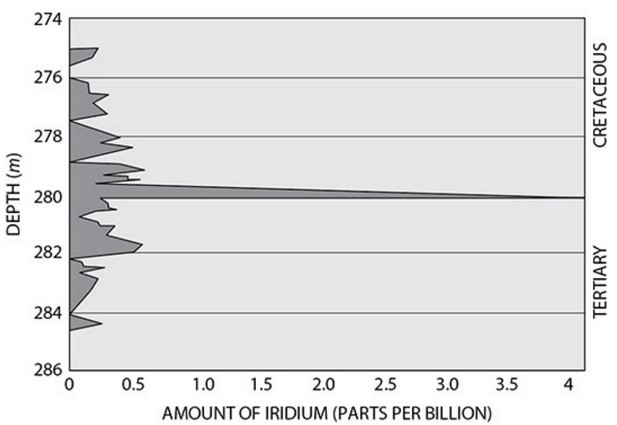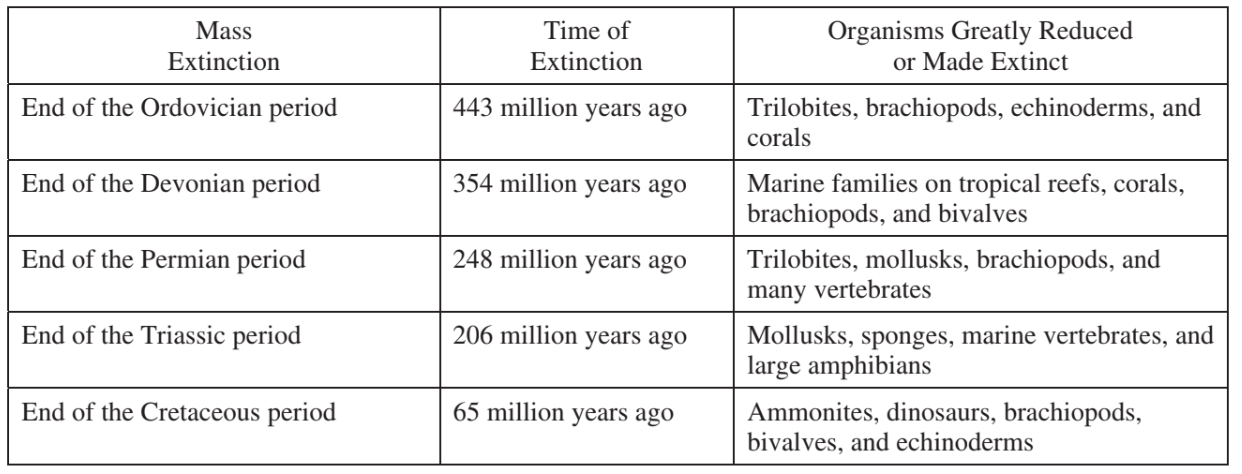Question
Refer to the graph below. Iridium is one of the least
abundant elements in the Earth’s crust but is often found at levels of 4–5
parts per million (notice graph is parts per billion) in meteorites that have
hit the planet.
Which of the following hypotheses is not supported by the evidence
that follows (hypothesis: evidence)?
(A) Rapid evolution/punctuated equilibrium: different compositions
of taxa are represented above and below the iridium rich layer.
(B) Mass extinction: many more fossils are present directly below
compared to directly above the iridium rich layer.
(C) Iridium layer poisoned some plant life: the composition of plant
biomass in the taxa above the iridium rich layer is different from
the composition of plant biomass below the iridium-rich layer. (D) Iridium-rich cloud blocked out the sun: greater biomass of plant
life is found directly above the iridium layer.
▶️Answer/Explanation
Ans: D
If the iridium-rich cloud layer blocked out the sun, plant matter
would be expected to decrease. The iridium layer settled to Earth, but
depending on the depth of the layer, the deposition rate, and some other
factors, a reduction in plant life is expected over the time the iridium was in
the atmosphere. When the atmosphere cleared, the plants that survived
would be expected to produce an increase in plant biomass over time, but
they would have to “rebuild” the biomass they lost in the initial reduction.
After an extinction event, diversity tends to increase slowly, at least at
first.
The hypothesis that the sun was blocked out and caused the mass
extinction, or was significant, is not generally accepted. It appears that the
impact, the temperature fluctuations that ensued, and the concurrent
massive volcanism all conspired to make Earth uninhabitable for about half
the kinds of organisms living on it. The exact cause of the massive
extinction has not been conclusively determined, but it is generally
agreed that the meteor played a large part in it.
The Cretaceous-Tertiary extinction (also called the K/T extinction)
ended the lineages of the nonavian dinosaurs, the ammonoids, rudists, many families of invertebrates and planktonic protists, and most marine reptiles.
Approximately 155 families of marine animals and 47% of all genera
became extinct.
See the box after answer 6 for a strategy for answering questions asked in
the negative and using the process of elimination.
Question.
A group of students summarized information on five great extinction events.

The students are sampling a site in search of fossils from the Devonian period. Based on the chart, which of the following would be the most reasonable plan for the students to follow?
(A) Searching horizontal rock layers in any class of rock and try to find those that contain the greatest number of fossils
(B) Collecting fossils from rock layers deposited prior to the Permian period that contain some early vertebrate bones
(C) Looking in sedimentary layers next to bodies of water in order to find marine fossils of bivalves and trilobites
(D) Using relative dating techniques to determine the geological ages of the fossils found so they can calculate the rate of speciation of early organisms.<
▶️Answer/Explanation
Ans:B This option is correct because it indicates that a student is able to design a plan for collecting data concerning speciation and extinction throughout the Earth’s history. The Devonian period prior to the Permian period did not contain vertebrates, which evolved later. Thus, an area prior to the Permian that contains a few early vertebrates would indicate the Devonian/Permian boundary, which would be an appropriate place for students to collect fossil data.
